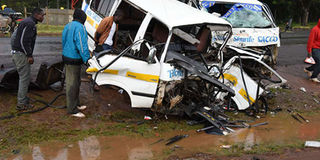Death-trap buses a result of flouted rules

The scene of a road crash at Maili Tisa. PHOTO | FILE | NATION MEDIA GROUP
What you need to know:
- Studies have shown that the fatalities could be avoided by universal adoption of the most basic preventive technologies.
- The tragic death of 10 pupils of St Gabriel’s Boarding Primary School near Mwingi Town raised similar questions over safe transportation of passengers in buses.
Public Service Vehicle (PSV) operators and vehicle body builders are flouting a State requirement to comply with new standards meant to enhance safety and comfort.
This means the majority of PSVs are potential death traps in case of road crashes.
Kenya adopted the new rules on May 22, 2017. The move to enforce the standards was informed by the rising number of fatalities blamed on poor workmanship on bus bodies.
The new code would see vehicle body builders embracing best practices such as strong seat anchorage, use of materials such as fibre glass, and use of plastics rather than heavy metals on seat handles.
The new body building standards, technically known as KS 372, were jointly developed by National Transport and Safety Authority (NTSA).
DAMAGE
In this week's tragic road accident at Fort Ternan in Kericho County where over 50 passengers were killed, the body of the bus became mangled after the accident, signalling it may have been substandard.
Studies have shown that the majority of motor‐vehicle‐related fatalities could be avoided by universal adoption of the most basic preventive technologies.
Road safety specialists also say the occupant survival rate is “badly compromised" by poor structural designs that crush passengers in case of an accident.
On Saturday, road safety campaigners and consumer lobbies warned that while there are laws and regulations that compel vehicle body builders to embrace best safety practices, enforcement agencies including the NTSA and Kebs are looking the other way, leaving the door open for corrupt PSV owners and bus body builders to flout the rules.
“While many may be quick to blame the drivers, often for exhaustion, speeding or drink-driving, the manner in which the Home Boyz bus roof and seats were ripped off raises credible questions about the stability and standards of a bus carrying such high numbers of people,” Consumer Federation of Kenya (Cofek) secretary-general Stephen Mutoro, referring to the Kericho ill-fated bus. “Safety belts mean nothing if the seats are easily thrown out of the bus,” he added.
LEARNERS
In August this year, the tragic death of 10 pupils of St Gabriel’s Boarding Primary School near Mwingi Town raised similar questions over safe transportation of passengers in buses.
The school bus had not complied with the new body standards.
At the time, Mr Meja was quick to link the move to timelines for when the law came into force.
“The bus body was constructed before the new body construction standards, which came into effect last year,” he had said. Mr Meja did not respond to Nation queries this week on compliance of the new PSV body standards.
Mr Simon Kimutai, chairman of the Matatu Owners Association — whose members control 80 percent of the country’s public transport sector — said NTSA and Kebs should do more to assist PSV operators obtain vehicles with the requisite standards.
“Manufacturers, for instance, should lower the quality of steel while inspectors should help us detect this,” Mr Kimutai said.
FATALITIES
Official data shows that the number of PSV licences issued increased by 9.3 percent to 33,349 in 2016, from 30,506 in 2015.
About half of these were for large capacity matatus known as minibuses (7,210) and buses (8,213), according to NTSA data.
It costs an average of Sh1.5 million to build the body for a minibus and more than Sh2 million for large buses. Between 3,000 and 13,000 Kenyans lose their lives in road crashes every year.





